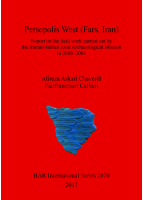Description
This book represents the final report on the field work carried out in 2008 and 2009 by the Iranian-Italian Joint Archaeological Mission at the archaeological site of Persepolis West, where parts of the town adjacent to the well-known Achaemenid monumental terrace of Persepolis have been located. The eleven trial trenches excavated in areas indicated by the results of Iranian and Iranian-French geophysical surveys represent the first stratigraphic excavations ever carried out on this site, the dating of which is supported by a rich series of radiocarbon datings. Illustration of the excavations is preceded by an accurate geophysical study of the topographical context and accompanied by a detailed and richly illustrated analysis of pottery and other finds: the safe stratigraphic context makes these finds a particularly important source of evidence for our knowledge of the ceramics of Fars during the historic pre-Islamic age. The excavations largely confirm the location of the built-up area of Parsa indicated by geophysical surveys.
AUTHOR
Alireza Askari Chaverdi, the Iranian director of the Iranian-Italian Joint Archaeological Mission, is an Associate Professor in the Department of History and Archaeology, Shiraz University, and Vice-Chancellor of the Shiraz University of Arts, Iran. He has carried out several excavations in Fars, focusing on the pre-Islamic historic periods, from the Achaemenid to the Sasanian period. Pierfrancesco Callieri, the Italian director of the Iranian-Italian Joint Archaeological Mission, is a Professor in the Department of Cultural Heritage of the University of Bologna, Italy. From 1977 to 2000 he worked in the Swat Valley (Northern Pakistan). In 2005 he started field work in Iran, focusing on the pre-Islamic historic periods in Fars.
Contributors: Babak Aminpour, Ali Asadi, Martina Battisti, Manuela Capano, Luca Colliva, Marco Galuppi, Sébastien Gondet, Nabil Ibnoerrida, Elisa Iori, Hamid Karami, Somayeh Khoshbakht, Fabio Marzaioli, Emad Matin, Alan Mercuriali, Kourosh Mohammadkhani, Isabella Passariello, Abazar Shobeiri, Filippo Terrasi, Mousa Zare
REVIEWS
'The volume is an important step towards a better understanding of the Pārsa cityscape, the post- Achaemenid settlement and the transition between the two periods. It is a must-read for anyone interested in the nonroyal parts of Pārsa city. Beyond that, it merits the attention of a broader range of readers interested in Achaemenid and post-Achaemenid ceramics and their chronology, in the creation of institutional landscapes, or in archaeological data relevant to the cuneiform Persepolis archives.' Zohreh Zehbari, Bibliotheca Orientalis (LXXVIII N° 3-4, mei-augustus 2021)
'The great value of this volume is in presenting and making available to the academic community the results of this important fieldwork project. The geophysical survey and ground-truthing of this data are pivotal to our understanding of the settlement landscape of Persepolis. The pottery assemblage retrieved through controlled stratigraphic excavation fills the gaps in the Achaemenid and post-Achaemenid ceramic sequence, with radiometric dating supporting these results...a very welcome and extremely valuable contribution to the archaeology of Achaemenid Iran. The material it presents will be indispensable to future research on the issues related to the settled complexes of the 'town' surrounding the Persepolis Terrace, as well as their extent and nature. It will also prove an enormously useful reference for the study of the ceramic sequences of the Achaemenid and Post Achaemenid periods of the Persepolis plain, which will further inform Achaemenid ceramic sequences for the greater Fars region and beyond.' Amanda Dusting, Ancient Near Eastern Studies Journal, Volume 56, 2019
'...a technical report addressing some key issues concerning the archaeology of Fars in the Achaemenid period...an indispensable source of information for further fieldwork in the region.' Ali Mousavi, American Journal of Archaeology Vol. 123, No. 3, July 2019
‘There is no doubt that the mission’s work and its results will continue to be analysed and interpreted by archaeologists dealing with the archaeology of Iran in the Achaemenid period for a long time, while the data will act as a point of reference in interpreting results obtained at other sites from the same period. For historians too, the results of the mission’s research are extremely interesting. It provided data that takes an entirely different perspective from the one known hitherto to depict the social and economic context in which Persepolis operated in the Achaemenid period and later eras.’
Edward Dąbrowa, Electrum, Volume 25, 2018
‘The methodology sections on ceramics and C14 analysis are very detailed and exact. … [The excavations provide] a series of glimpses into the gardens and possibly built landscape surrounding Dur Parsa that is not found in such detail anywhere else. This book makes a vital contribution to the collection of knowledge on Persepolis.’ Dr Tobin Hartnell, The American University of Iraq, Sulaimani
‘At a fundamental level, this is one of the most important publications on the archaeology of the heartland of the Achaemenid Empire of Iran to appear in the last 50 years.’ Dr Cameron Petrie, Trinity College, Cambridge











